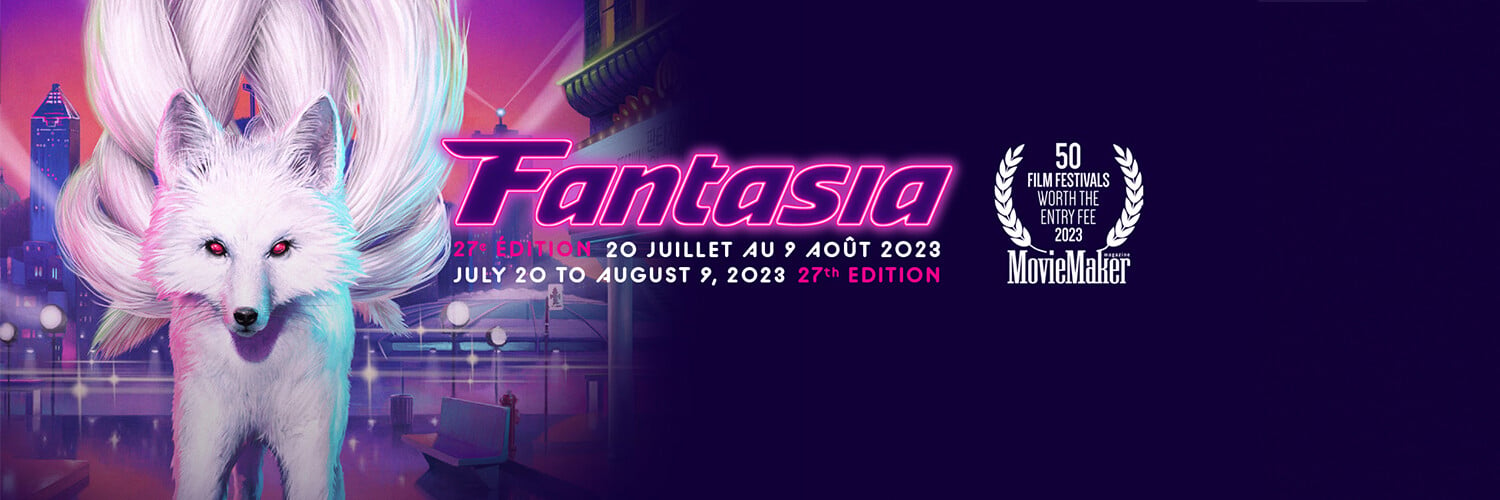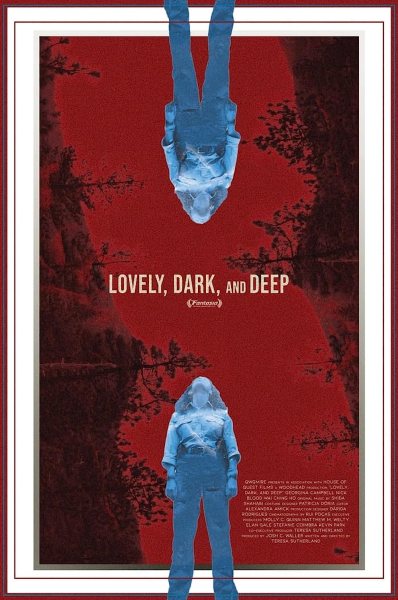


I was lucky enough to chat with Teresa Sutherland, writer and director of Lovely, Dark, And Deep, and not only was it a really fascinating insight into the creative process behind the film but it was also a blast to shoot the shit with someone about stuff that creeped us out.
Justin: The 411 phenomenon is something of a hot trending item right now in pop culture, but this movie made it work. How did you approach it without having it fall into cliches?
Teresa: It was like ten years ago, I was on YouTube, looking for scary shit, middle of the night, just wanting to be creeped out, and I came across some of these stories and it really got to me and I decided I was going to figure out what this was for me. That was before I wrote The Wind, so I wrote The Wind, came back to it, and I think a lot of what I wanted to do was find the thing that would be the scariest explanation for me. What would really be scary. Of course, if I was in the woods and saw Bigfoot, I would be terrified, but in my head that’s not where I go for the chills. And something I’m very conscience about as a horror writer/director is trying to find things that feel different, trying to find things that an audience may not have seen before or tell the story and show the story in a way they haven’t seen before, and it was all kind of tied into…I was digging cosmic horror at the time, and it all started coalescing into this…it is the woods itself it is what is there, it is this thing, that whatever it is taking people and if we were to save one of these people it would want us to replace them. Once that came to me, it was clear for me how I wanted the story to unfold.
Justin: In the description of the film, it was referred to as “folk horror”, and I worried they were just calling it that because it took place in the woods, but once there was that line “I owe this land a body” and it was clear there was this kind of bargain struck there, like a Lovecraftian Innsmouth kind of situation, that is really scary. And the whole 411 thing, I’m not sure if I believe it but it’s still terrifying to think about.
Teresa: I’m a massive skeptic. I’m an optimistic nihilist. Like nothing probably matters but it would be great if it did (laughs) So being able to create something that plays off cosmic horror but it’s something here it’s just something we don’t understand, and we haven’t faced and looked at. And it’s in these spaces, and maybe we have pushed it into these natural spaces because we keep encroaching on it and taking land and building on it and here’s where it’s comfortable. So, it’s been fenced off in our national park and that’s where it likes to be. I love to take a conspiracy and take it apart and think about it for days.
Justin: Trust me I live for this stuff, and even though I don’t believe like 90 percent of it, I’m still not going to go swimming in Loch Ness.
Teresa: I’m not gonna say ‘bloody mary’ into a mirror! But…I also think it would be fine. (laughs)
Justin: One of the things as this movie progressed I really appreciated was there were all these shots of just wide open space. Last April I drove from LA back here to PA, and at one point I stopped in Nevada at night at the Extraterrestrial Highway sign and took a picture, and the next day when I drove by that same spot on my way to Vegas, I realized that just behind me, in the dark, was this massive expanse of nothingness in the desert, and there’s something terrifying about that. Was it a conscience choice on your part to show the smallness of Ranger Lennon against the vastness of the park?
Teresa: It was important to me to show that this place was big. There’s this video to show how big of a space and it’s like ‘here’s Earth!’ and then it zooms out and we’re a tiny speck and then it zooms out more and more. Our brains are so used to seeing this concept of bigness that even here on earth we don’t know how big these spaces are. Like these are massive spaces and very easy to get lost in if you find yourself there. It was absolutely something we wanted to get across that there is so much around her that is wilderness, that she will not see a person. In the script, when I was doing research, I found the ranger stations are twenty miles away from each other. So, her nearest neighbor would be twenty miles. So just the idea that it would be twenty miles in any direction before you came across another person or structure that wasn’t natural, and then on top of that we showed how many rangers you would need just because you had massive amount of land. So yeah, in the end when the camera pulls up, I wanted to show that she is so small, and we are so small here.
Justin: I love that. The whole idea of national parks and the emptiness is so humbling. Where did you guys film this? Was it at a national park?
Teresa: It was filmed in Portugal. The script is set in Sequoia, and I wanted to have a Sequoia/Yosemite look, like half this Western/Rocky look, like the trees are a certain way. When the first group of producers came on, they had some land in New York, and they were like ‘we could shoot this movie here’ and I was doing some research on it and felt that it wasn’t what I envisioned but I’d make it work. And then Josh Waller (of Woodhead Creative) read the script and contacted me, and we talked about it and he sent me some pictures of Portugal and I was like ‘this. This is amazing.’ We all came together and found ourselves in Portugal. We shot all over the country and had three weeks to shoot it. I swear to god there were at least twenty locations. It was a massive push. We were in a town called Sintra and around there, and her ranger cabin is on a hiking path that we found so we just blocked off the path and had to pause while a bicycle came through (laughs). And then some of the bigger mountainous areas were like four hours away. We got to go to some of the places that were usually chained off and really get into the park with a retired national park ranger who was our guide and was really excited to show us our park and he was so excited.
Justin: You guys really nailed it. I was watching it and trying to figure out which park you guys shot it at and couldn’t figure it out.
Theresa: The name we chose for it Arvores is Portuguese for ‘trees’. So, I was like let’s get some words for it I really want to pay homage to where we’re shooting, and all the native speakers were helping, and I was like ‘I like this. Now how would Americans say it?” (laughs)
Justin: So, something I’ve always appreciated in horror films is the use of past trauma as a source of horror. Was having her trauma involve her younger sister a specific choice? Like was it her sister for a reason?
Theresa: So long ago, when my reps were taking the script around, someone suggested it should’ve been her daughter who went missing, something that was part of her soul. And I get that, but I also think-like I have a sister, and it happening to her when she was so young and internalizing the blame and the guilt for it, felt like something that would happen to a child like ‘you were supposed to be watching her, you lost track of her’ it’s something that would consume her and she can’t break out of that and it’s affected every part of her life. It’s affected her job choice even. She’s trying so hard to get back to this space where her sister was. It’s about those childhood traumas and those generational traumas that we all have, and we all hold inside of ourselves and having to look at that. We have to look that in the eye and face it and really get in there just to come up the other side of it. And it doesn’t mean it goes away. It doesn’t mean that it’s okay. It doesn’t mean that it means we’re going to make better choices and be better people, but we have to do that for ourselves. And that was the big part of the arc of Ranger Lennon was just having-it’s not about finding out what happened, it’s about facing what happened and forgiving yourself and letting that part of you say you’re sorry.
Justin: It’s interesting you said that, about making better choices. There’s a part in this movie about a missing hiker and a choice is made that isn’t exactly heroic, or good, so to speak. Was that a specific choice to tie in with the nature of trauma and how we process it?
Teresa: Yeah. I’m not huge on happy endings. And I also think happy endings mean different things for different people. Like tying it all up, and making it feel good, it might not always feel good. I think that’s reality, decisions don’t feel good sometimes, or we don’t know what the right one is to make. And I think that very last beat is a very human choice, and it’s a choice that if someone sees I hope it sticks with them. Because I do think there is no right choice in that situation, because she knows what’s gonna happen if she calls it in and we’ve seen what’s going to happen. And that is not fun or cool. (laughs). So having to be like ‘I will face this gain. I will face oblivion again. Or I’m gonna stay in this space where my sister is until I can figure it out.” Maybe that’s what she’s doing.
Justin: I thought that was really refreshing. We like to think we know what we’d do but we don’t ever really know until we’re faced with this weird cosmic horror.
Teresa: And then learning about the other rangers who’ve been working there for years, and what they’ve let happen. And these are people you think ‘oh they seem nice and helpful!’ And I think that speaks to lot about us as human. We’re not all we show ourselves to be all the time.
Justin: Thank you so much for taking the time to talk to me. I love being able to talk to creators and pick their brains and seeing what makes the engine move.




